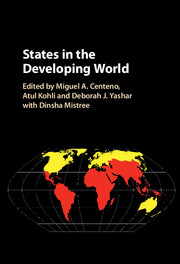Book contents
- States in the Developing World
- States in the Developing World
- Copyright page
- Contents
- Contributors
- Figures
- Tables
- Preface and Acknowledgments
- 1 Unpacking States in the Developing World: Capacity, Performance, and Politics
- Part I Order and Reach
- Part II Economic Development
- Part III Inclusion and Equity
- References
- Index
- References
References
Published online by Cambridge University Press: 16 February 2017
- States in the Developing World
- States in the Developing World
- Copyright page
- Contents
- Contributors
- Figures
- Tables
- Preface and Acknowledgments
- 1 Unpacking States in the Developing World: Capacity, Performance, and Politics
- Part I Order and Reach
- Part II Economic Development
- Part III Inclusion and Equity
- References
- Index
- References
- Type
- Chapter
- Information
- States in the Developing World , pp. 423 - 466Publisher: Cambridge University PressPrint publication year: 2017

